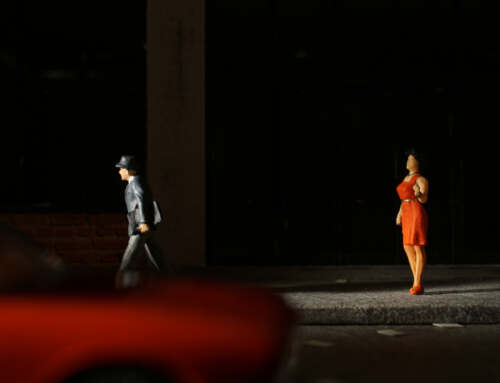I remember when I first met Kristina she was looking for a fellow photographer who liked breaking the rules. My reaction at the time was confusion, because I didn’t know what those rules were. Recently I came across a list of basic photography ‘rules’ and I was pleasantly surprised. Both by what the rules are and were I fell on the spectrum of rule breakers.
The Rules
- Focus on the center of interest.
- Fill in the frame with the subject.
- Do not shoot between 10 AM and 3 PM. (The light is too harsh.)
- Do not shoot against the light.
- Hold the camera steady.
- Follow the ‘rule of thirds’: e.g., 1/3 sky and 2/3 land or 2/3 sky and 1/3 land.
- Obey the light meter.
- Photograph children (and pets) at their own eye level.
- Avoid lens flare when shooting against the sun.
- Keep the camera level with the horizon.
Now that we know what the rules are, lets look at what breaking those rules might look like.
Breaking The Rules
- Keep the center of interest out of focus: play with the balance of forms.
- Allow space around the subject; look for interaction with the environment.
- Shoot on any day, at any time.
- Photograph only against the light for a month.
- Shoot while jumping up and down or spinning around.
- Vary your composition. Respond emotionally.
- Disobey. Mess up the zone system. Overexpose and underexpose by three, even four f/stops.
- Move up, down, on the side, all over.
- Use lens flare to enhance a composition
- Create your own horizon.
I may not be the biggest rule breaker, but I do consistently break rules 2, 4,7, and 9. I used to follow the rules much more than I used to. At one point I couldn’t imagine photographing against the light or disobeying the light meter by overexposing my image. Now I do this all the time, it’s practically second nature. In fact, I think by breaking the rules my photos are better. Because of the success I’ve had breaking the rules so far, I want to look closer at some of these other photographic rules.
The rules I’m most interested in experimenting with are filing the frame, eye level and focus points. Looking at the rule about lens flare makes me think of the beautiful work of Christoffer Östburg and his manufactured lens flare. Maybe I need to look at his technique and see what I can create; experimenting is so much fun!

Trying to break the rules. 🙂
With a little trial and error, maybe we can all learn to become the photographers that Kristina is looking for. Or if not those photographers, at least photographers willing to mix it up, make mistakes and break a few rules along the way.
Shelly
My questions to you are:
- Do you break the rules?
- Which rules do you enjoy breaking the most?
- Are there other ‘rules’ you enjoy breaking?
- Which rule(s) would you never break?
- Now that you know what the rules are, can you see yourself deliberately going out of your way to break them?
If you enjoy what we’re creating here on the blog, we invite you to join our G+ community. You’ll find friendship and conversation in a supportive environment.
Also, don’t forget to subscribe to the blog so we can send you our weekly round-up!







Really interesting post. There’s a whole lot of rules there that I didn’t know about! (And some that I did but like breaking all the same!!) I want to play with filling the frame, as it’s something I don’t tend to do it that often (I don’t think) and with toys could be a fun challenge!
Im glad you liked the post Lizzi! I also am intrigued by ‘filling the frame’. I fear that I’m too much in love with the empty spaces to do it effectively. But I also think its good to step out of one’s comfort zone. I look forward to seeing if you can push some of your own boundaries in the coming months. Thanks for joining the conversation!
I wasn’t aware of all the rules – and I think things like f-stops and exposure rules only really work if you are using D/SLR camera (I have no idea where the f-stop might be on my phone!)
But perhaps that’s the point. The simple rule of any successful image should be that it tells a story in a snapshot. If that means making your object of focus behind the thing at the centre of the picture, then fine.
I can see the rule for eye level working though – and it applies to toy photography as well. If you shoot down on something then it becomes an object rather than the focus of the story… but again, it depends on what the goal of the image is.
BTW – I always thought the rule of thirds was to divide the image frame with two vertical and two horizontal lines, and the subject should be on these lines… on the thirds. This way the image looks more active than a straight portrait image.
A good post though – thank you 🙂
David, the ‘rule of thirds’ i mention here is just one of the most basic definitions. I wrote an entire post on The Rule of Thirds which you can read if you’re interested:
http://toyphotographers.com/2016/09/15/the-basics-rule-of-thirds-etc/
You are so very right when you say many of these rules are aimed at d/slr cameras. But there are apps you can use on your phone that can emulate these effects if you’re interested in playing around. With toys I think that we are so used to getting down to their level that a more interesting angle is looking down on them. Playing with shadows and geometry of placement. With all ‘rules’ you have to read them with a little skepticism and know that they are only one place to start. And you’re right – it all depends on what your goal is. Thanks so much for joining the conversation!!
Very interesting post Shelly! I don’t pay that much attention to the rules, I generally just shoot what I like. I do like to angle my horizon sometimes – I think it’s more interesting in motion shots.
I had to laugh at #5 in your “Breaking the rules list” (Shoot while jumping up and down or spinning around) – that brings back memories from my twenties and playing with cameras on the trampoline. Funny what gymnasts will do when they’re bored 🙂
Im glad you enjoyed the post Lynn! If you’re interested in the art of blur there is an entire six week photography mentorship on G+ that is focused only on Blur. I’ve seen some amazing images come out of that mentorship! If you’re interested in getting back to your own roots, you can check it out. 🙂
That does sound interesting! I’ll have to check it out, once I’m more acquainted with Google +. Thanks Shelly!
I would have to agree with Lynn on this one. I just shoot what I like. I know one of those rules, the rule of thirds, but I almost never use it. In fact, it feels like I’m breaking a rule when I do use it. And not shooting between 10-3 is like a challenge for me. That’s when I do most of my shooting, so I look for places that soften the light as much as possible, whether I’m indoors or outdoors.
This was an interesting read, Shelly. Who knows, maybe now I actually know what the rules are, I may use or break them on purpose!
Pinar, it doesn’t matter if you use the rules or break the rules. They are only a place to start or a place to move away from. As long as you’re having fun, creating images that make you smile and express who you are – then who needs rules? Like you I often photograph in the middle of the day, I love looking for places with soft light or in the shadow. The hunt is half the fun! Cheers my friend!
I often don’t think about the rules but when I do it’s usually the rule of thirds when editing. Usually a slight crop to bring the subject right on point can make a huge difference. But generally I shoot with an image in mind and play around with lighting and composition to get what I like best. And that could be shooting from above the object. Live view on the dslr helps immensely with this. But photography is all about creating what’s in your mind and having fun doing it. Rules or no rules, I’m sure we all do that.
Absolutely, its all about the fun! If you pay too much attention to the rules / guidelines you can lose focus of the real goal: creating interesting and meaningful work.
FYI: rule of thirds is composition. And like all ‘rules’ it’s a guideline and only one way to look at how to crop your photo.
🙂
> Do you break the rules?
Yes. Tho I don’t think of them as rules – merely starting points for beginners.
> Which rules do you enjoy breaking the most?
rule of thirds.
> Are there other ‘rules’ you enjoy breaking?
I’ve never used a light meter and I don’t see any reason to start now. I have broken all of these “rules”, and I am not sorry about it
> Which rule(s) would you never break?
Thou shall not murder.
> `Now that you know what the rules are, can you see yourself deliberately going out of your way to break them?
Sure!
Starting points for beginners – yes, that is what they are!
Rule of Thirds is overrated. Once you start looking down that rabbit hole there are so many different and viable ways to think about composition mathematically. That one simply has the catchiest name.
I never use a tri-pod. we’re even. Also the ‘sunny 16’ rule still works!
Thats a good rule, I like that one!
When I was in school 30+ years ago, these rules didn’t exist. When Kristina mentioned the rules back in 2015, I didn’t even know what they were. I was amazed to find someone actually out a list together.
When I write posts like this, my only goal is for my fellow toy photographers (most of them new to photography) to think about what they are doing. To create work with intention.
Thanks for the wonderful reply!
“Which rule(s) would you never break?”
I only have one, and it’s a pet peeve when looking at others’ work. While I am sure it could be broken – on-purpose and for intended effect – with success, when I see it I wince. When I DO it, I berate myself soundly. Water, in the distance, forming the horizon line, needs to be level. It’s a peeve, I know, and yet I look for it every time.
Ryan, I hear you. I also wince when I see a horizon askew since it is usually an easy fix. If you’re going to move the horizon line, then really change it. At least that way we know the photographer is creating an image with intention. Thanks for sharing your thoughts on this post! 🙂
There’s rules? It’s probably easier to break them if you don’t know they exist!
At the risk of losing my ‘knucklehead’ moniker, I actually studied photography at college (Shhhh!), so I heard of these ‘rules’. Plus, I’ve read some wonderful posts about the basics of photography by someone.
Do I follow these rules? Maybe. Do I break some of them? Yes.
Without scrolling back to look for broken rules (someone already made me do that with their wintry wonderfulness), I think I break 1, 2, 3, 4, 6, 8 and 9 regularly? Quite an impressive rap sheet!
Keeping the camera level with the horizon is one rule I struggle to break. There’s something about a wonky horizon that make me feel uneasy? It’s almost an unsteady queasiness. But maybe that’s what that rule breaking is meant to do? 🙂
You impress me yet again my friend! I love that you break so many rules! I don’t think I break nearly as many as I like. Ive always had ‘good girl’ syndrome.
You, me and Ryan can all agree that straight horizons are a ‘must have’. Although I will confess I twisted the camera for the Chima image with this post to emphasis the slope he was on. If you break a rule and no one can tell, did you still break it? 😀
Hey, thank you for listing these rules and making me reflect them. Here’s what I came up with (and hope this is not too long):
1. Focus on the center of interest – mentally, yes! I always try to do so. Sometimes that may lead to not focussing physically…
2. Fill in the frame with the subject – That really depends on the subject, doesn’t it? If it is, say, “sea and sky”, it’s impossible not to fill the frame with it… If I want to present the smallness of somthing, not filling the Frame might do the Job.
3. Do not shoot between 10 AM and 3 PM. (The light is too harsh.) – Some of my favourite photos were made within that time window.
4. Do not shoot against the light – how else would I produce silhouettes?
5. Hold the camera steady – again, that depends on the intended result.
6. Follow the ‘rule of thirds’: e.g., 1/3 sky and 2/3 land or 2/3 sky and 1/3 land – This rule can come in handy (although I mostly prefer the “Golden Rule” which is not quite the same), but this ‘rule’ aims at harmony. If you do not want to convey a feeling of harmony, well…
7. Obey the light meter – it’s often wrong! I usually check the highlights and the deep shadows…
8. Photograph children (and pets) at their own eye Level – since I almost never photograph them, I would not know anything about this rule. Again, I would think everything depends on your Intention.
9. Avoid lens flare when shooting against the sun – And again, do as you please. I am no fan of flare but sometimes like it in other people’s pictures.
10. Keep the camera level with the horizon – If you tilt it, make it look like it is not an accident, that’s my rule.
…and sorry there’s an auto-correct at work here which I cannot always correct.
+1000 ^^
1. Do you break the rules?
Yes, yes, yes.
2. Which rules do you enjoy breaking the most?
1-2-3-4-8
3. Are there other ‘rules’ you enjoy breaking?
Photo “clean” and without spot or wear. These imprints of time are a testimony of life. I wish to show them, sometimes they are what is most remarkable on some photos. (Wabi-Sabi / Zen)
4. Which rule(s) would you never break?
Perhaps 1/3, 2/3.
5. Now that you know what the rules are, can you see yourself deliberately going out of your way to break them?
^^
One rule I believe we should always challenge (even if you don’t break it) is ‘obey the light meter’. If we let the camera do this for us we are looking at making what’s at the centre a nice, even blandness. Even spot metering is trying to drag the subject to the correct exposure for 18% grey. That’s cool if you have a subject with olive toned skin, but that tends to limit toy photographers.
So, if there are people who use Program, or Auto functions reading this (and that’s cool too) I’d like to suggest the following: use exposure compensation. Cameras have exposure compensation functions for a very good reason, and I think every photographer that uses automatic exposure should take a little control.
What have digital toy photographers got to lose?
Tony, Great point! I think we rely too heavily on the light meter no matter what setting we are using. I think its healthy to play around with the exposure to see what might turn up. I remember when I was photographing the white batman in the snow and I wanted it to have a dark brooding look. I mean its Batman for goodness sake, he should be dark and brooding, right? But when I over exposed the image, it really popped. I love the Sony because you can see these changes in the view finder. And your right, with digital photography, we should be experimenting more. We just don’t have that much skin in the game like you would with film. Thanks again for bringing up such a great point!